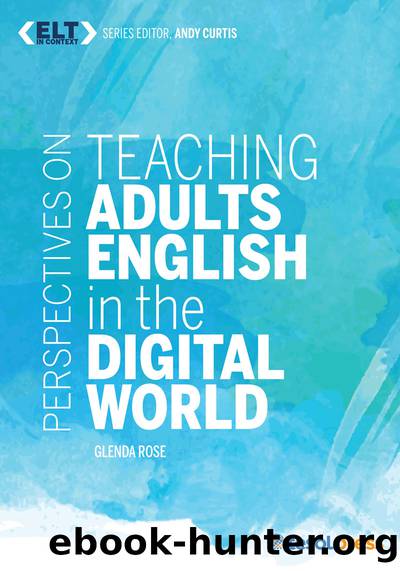Perspectives on Teaching Adults English in the Digital World by Rose Glenda;Curtis Andy;

Author:Rose, Glenda;Curtis, Andy;
Language: eng
Format: epub
Publisher: TESOL Press
Published: 2015-08-15T00:00:00+00:00
Adult Education English Language Programs
Approximately 77,000 teachers in the United States work in adult education, which primarily includes teaching basic literacy, teaching English as a second language, and preparing adults for the General Educational Development test (National Center for O*Net Development, 2010). Without giving specific details, the U.S. Bureau of Labor Statistics (2014) states, âMany positions for this occupation are part time, and full-time positions are uncommon and difficult to find. As a result, prospects will be best for workers who are willing and able to take a part-time position.â Being part-time means that most instructors teaching English as a second language to adults in community programs have no insurance or retirement benefits. Some adult education teachers have full-time jobs in education or other fields. Some are retired or have other sources of support such as a working spouse or partner. However, many have to juggle teaching posts at two or three organizations in order to make ends meet.
In my early career, all of my teaching positions were in the evening, 2 to 3 hours a night, 2 or 3 nights a week. Twenty to thirty students made their way into the classroom after working long hours in mostly physically demanding jobs. For publicly funded programs, financial support is funneled from the federal government through the state to local programs through the Workforce Investment Act (WIA) of 1998. The WIA was replaced by the Workforce Innovation and Opportunity Act of 2014, but at the time of this writing it is unclear exactly how the new act will impact adult education, especially English language instruction.
WIA was intended to provide resources for members of the population with the most need: âlow income adults who are educationally disadvantaged; individuals with disabilities; single parents and displaced homemakers; individuals with multiple barriers to educational enhancement, including individuals with limited English proficiency; criminal offenders in correctional institutions and other institutionalized individualsâ (U.S. Department of Education, 1999).
In other words, the English language students I taught in publicly funded programs worked hard, but they were generally living below the poverty level in the United States. These students had priority in the class based on funding, and the class was almost always full. Because of their socioeconomic situation, a host of other considerations had to be on my mind as an instructor. Could my students afford to buy a textbook? Could they even afford to buy paper? Did the story a student just told about his interaction with an employer indicate exploitation or discrimination? What did another student mean when he said there was no water at home? Was the plumbing broken or was he unable to pay the water bill? I imagine every English language teacher in publicly funded adult education in the United States could add dozens of questions to this list. As their instructor, I tried to make the classroom a safe, welcoming environment. Outside of my class, the majority of these students were invisible people: construction workers, housekeepers, food vendors. In my class, if nowhere
Download
This site does not store any files on its server. We only index and link to content provided by other sites. Please contact the content providers to delete copyright contents if any and email us, we'll remove relevant links or contents immediately.
Whiskies (Collins Gem) by dominic roskrow(44645)
Spell It Out by David Crystal(35920)
Cecilia; Or, Memoirs of an Heiress — Volume 1 by Fanny Burney(32198)
Cecilia; Or, Memoirs of an Heiress — Volume 3 by Fanny Burney(31587)
Cecilia; Or, Memoirs of an Heiress — Volume 2 by Fanny Burney(31548)
Beautiful Disaster by McGuire Jamie(25086)
Trainspotting by Irvine Welsh(21224)
Chic & Unique Celebration Cakes by Zoe Clark(19846)
How High Can a Kangaroo Hop? by Jackie French(18701)
The Secret History by Donna Tartt(18467)
Twilight of the Idols With the Antichrist and Ecce Homo by Friedrich Nietzsche(18389)
All the Missing Girls by Megan Miranda(15088)
Cat's cradle by Kurt Vonnegut(14929)
Ready Player One by Cline Ernest(14217)
Fifty Shades Freed by E L James(13018)
Crooked Kingdom: Book 2 (Six of Crows) by Bardugo Leigh(12050)
4 3 2 1: A Novel by Paul Auster(12001)
For the Love of Europe by Rick Steves(11936)
Grundlagen Kreatives Schreiben (German Edition) by Helfferich Pia(10322)
